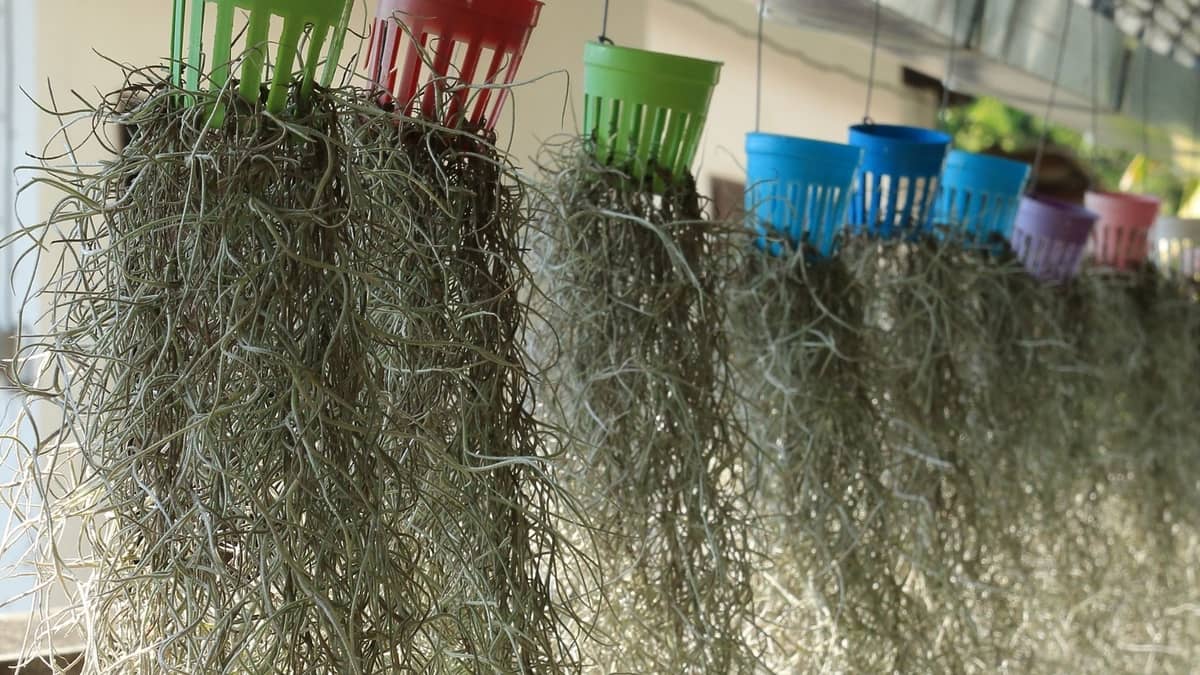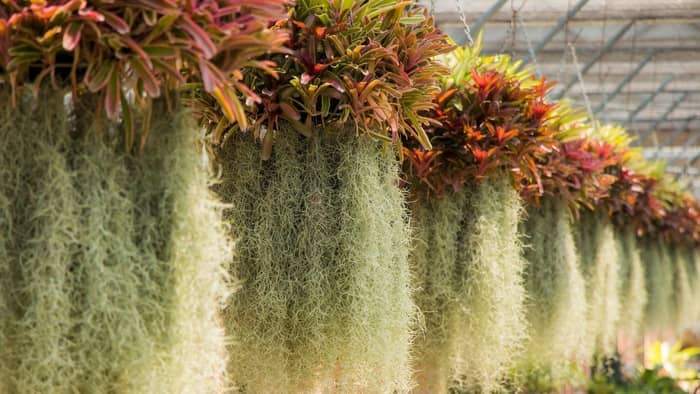Last Updated on April 18, 2022 by Marco C.
Given just how versatile this plant is, many people wonder can you grow Spanish moss indoors. This plant was traditionally used as stuffing for pillows, mattresses and various types of furniture – today, though, it’s used for flower arrangements more than anything else. This makes it a great addition for anyone who’s into arts and crafts.
In today’s article, we’ll be learning how to grow your own Spanish moss indoors.
Growing Spanish Moss Indoors
The only way to grow Spanish moss indoors is to simulate the growing conditions that it’s used to in the wild.
When it comes to choosing your pot, it’d be best to use hanging pots. You don’t have to if you don’t want to – some people don’t like drilling holes in the ceiling and attaching hooks – but if that’s okay with you, you’re going to get the best results this way.
Remember that in the wild, Spanish moss hangs off of tree branches, and the best way to simulate that indoors is by hanging the moss from the ceiling. If that isn’t an option, though, you can use regular pots and just put them on the windowsill – since there’s free space below the sill, the moss will grow just as well.
That brings us to our second point – windows and lighting. These plants like the sun, but not too much of it. They need partial shade – bright and indirect lighting – so it’d be best to put it next to an eastern window or a part of your home that’s bright but with no direct lighting.
The reason it prefers indirect light is because it’s used to growing under tree branches and those branches provide the moss with natural shading. It needs natural lighting, so growing it with LED lights isn’t going to do it any good.
When you’re choosing your moss, don’t take it from the wild (no matter how tempting that option might be) – just buy your moss from a garden store, which usually has clean moss. This way, you’re not risking bringing parasites and bugs into your home.
That’s about it when it comes to choosing the location and lighting – moss is usually very easy to grow and it doesn’t require much care – which is our next topic.
Learn more about: How to Plant Irish Moss Seeds?
Spanish Moss Care
Temperature and humidity are the two most important elements of Spanish moss care. They can grow very well at room temperatures and it shouldn’t drop far below that – even though, interestingly, they can survive frost.
You’re going to control the humidity through watering – people find this as the most difficult part of keeping Spanish moss healthy, as it’s difficult to water a plant that literally doesn’t grow in soil.
However, the simplest solution comes in the form of spraying. In the wild, Spanish moss gets its water mostly from rain, and you’re going to simulate that rain by spraying water.
Don’t use tap water for spraying the moss unless you’ve dechlorinated it – it’d be even better if you can get natural water from a pond or a stream. You should be mindful not to overwater it, though – moss is very susceptible to rot, and this is what usually happens when you overwater your moss.
Let it dry off before you water it again and shake off all the excess liquid.
Lastly, when it comes to fertilization, the best way to fertilize it is through spray – there are fertilizer sprays, but also solutions that you can dissolve in water and then use in your spray – it doesn’t really matter. Fertilization is important because these plants get their nutrients regularly in the wild, growing on trees with many minerals.
Spanish Moss Uses
Traditionally, Spanish moss was used as stuffing material for anything that needed to be stuffed – car seats, pillows, mattresses, blankets, home insulation, etc. It was also used as horse food (and still is in the wild). Today, you can still see some traditional uses.
For example, some companies use it for stuffing in packages when they’re sending fragile goods. However, it’s mostly popular with florists, who can make beautiful arrangements with it, as well as people who are into arts and crafts.
In the wild, it can be used to start and sustain a fire, while animals naturally use it to build nests and as a source of food. It isn’t edible for humans, though, and it can actually cause a rash for some people.
Read more about: How to Make Moss Terrarium?
FAQ
Is Spanish moss good for houseplants?
Spanish moss isn't harmful for any houseplant and it won't get in the way of anything. They're used to natural symbiosis, as they grow on tree branches in the wild and use them for their nutrients.
Where do you put Spanish moss indoors?
Spanish moss prefers indirect sunlight, so you shouldn't place it in front of a window that gets plenty of light. It needs plenty of water, which is best provided through spraying, so the humidity needs to be high. The temperature should be around room temeperature.
What does Spanish moss need to survive?
They need additional fertilization - in the wild, they get all their nutrients from trees and ponds. They will often hang into bodies of water, which allows them to drink the nutrient-rich water. When you're growing it indoors, you need to provide those nutrients.
How to hang Spanish moss indoors?
You can either hang it in hanging containers that you'll hang from the ceiling, or you can put the container on the windowsill. However, the latter option isn't as good.
To End
Spanish moss is easy to grow indoors if you can provide it with enough water through spraying and just enough light. They prefer partly shaded areas, so you don’t want to put them in direct lighting. It would also be great if you could hang them from the ceiling, instead of putting them on a windowsill.
Try to keep the temperature at room temperature. This herb is great if you’re into arts and crafts, but they’re also often used for some other things.


